In a mountain forest ravaged by fire in Jasper National Park, charred trees stand alongside a few that look like giraffes, their blackened trunks dotted with golden patches. Locals have taken to calling these strange beauties giraffe, cheetah or leopard trees.
Parks Canada wildfire specialists don’t have a name for this and neither apparently do their Canadian Forest Service/Natural Resources Canada colleagues. But they do know that this phenomenon is indicative of the kind of extreme fire behavior seen when the Jasper Wildfire Complex tore through this Alberta park last summer and when the Kenow Wildfire ripped through Waterton Lakes National Park in 2017.
“A high-intensity fire rapidly heats tree sap,” explains the park’s communications officer Karly Savoy. “As the inner bark and sapwood die and quickly lose moisture, the outer bark becomes loose or pops off, either due to the inner bark contracting or steam escaping (or both). Flaking continues as the tree dries out more and the bark loosens off. Wind, rain and birds can cause further flaking.”
Savoy couldn’t find any research yet on the subject, but perhaps somebody is quietly looking into it.

The forest around Jasper's Lake Annette was once thick but since devastating wildfires you can see right through it/Jennifer Bain
I visited Jasper in mid-November to see how the park, which is home to the community of Jasper, is doing. The monster wildfire that began July 22 burned through 79,000 acres, forced about 5,000 residents and 20,000 tourists to flee, and levelled a third of the town. It wasn’t brought under control until Sept. 7 and was declared a “complex” because it involved three separate fires, including two that merged.
Of 1,113 structures in town, 358 were destroyed. Critical infrastructure like the hospital and schools was spared, but three hotels were lost along with a handful of restaurants and businesses like gas stations. The biggest fire in the park in more than a century caused about $800 million Canadian (that’s $628 million USD) in insured losses making it the most-costly insurance event in Canada’s national park history.
Jasper, for those who haven’t been, is a national treasure. It stands in the shadow of globally renowned Banff National Park, but it’s Canada’s largest Rocky Mountain park and the world's second largest Dark Sky Preserve. It draws about 2.4 million visitors a year, spans 4,335 square miles of mountain terrain and is home to abundant wildlife.

A white-tailed deer pauses along Pyramid Lake Road/Jennifer Bain
On my drive into the park from Edmonton (the closest airport), I spot bighorn sheep blithely strolling the Trans-Canada as usual, elk on the edge of town and white-tailed deer on the back roads. The black bears that temporarily took over town have retreated to the woods. The southern mountain caribou herd is, as always, safely hidden in old-growth forest and high alpine areas, and a nearly complete conservation breeding facility escaped serious harm. (More on that in an upcoming story.)
My visit coincides with a news conference announcing federal funding. Small businesses will get $3.45 million ($2.46 million USD) in grants from the new Jasper Business Recovery program. About 325 small businesses will share that money, with up to $5,000 ($3,567 USD) going to sole proprietors and $10,000 ($7,125 USD) going to incorporated businesses that lost revenue from the last nine days of July, all of August and most of September.
Tourism Jasper gets half a million dollars ($357,000 USD) to encourage visitors to return and animate the town, money that will offset some of what it lost in destination marketing fees usually collected from visitors by hotels and other participating businesses.

New growth emerges from the ashes of the Jasper Wildfire Complex/Jennifer Bain
But is Jasper really ready for visitors?
“There was a time when there was some hesitation. People were still just coming to terms with personal loss and it was a trying time for everybody,” Mayor Richard Ireland told the news conference. “I think, without doubt, the overwhelming attitude now is yes, we all rely on the same economy — it’s the visitor economy. You will be welcome and every visitor is needed.”
Marmot Basin just kicked off the skiing/snowboard season. The Jasper in January festival runs Jan. 10 to 26. Most frontcountry and backcountry campgrounds will reopen next summer and online reservations will launch in January.
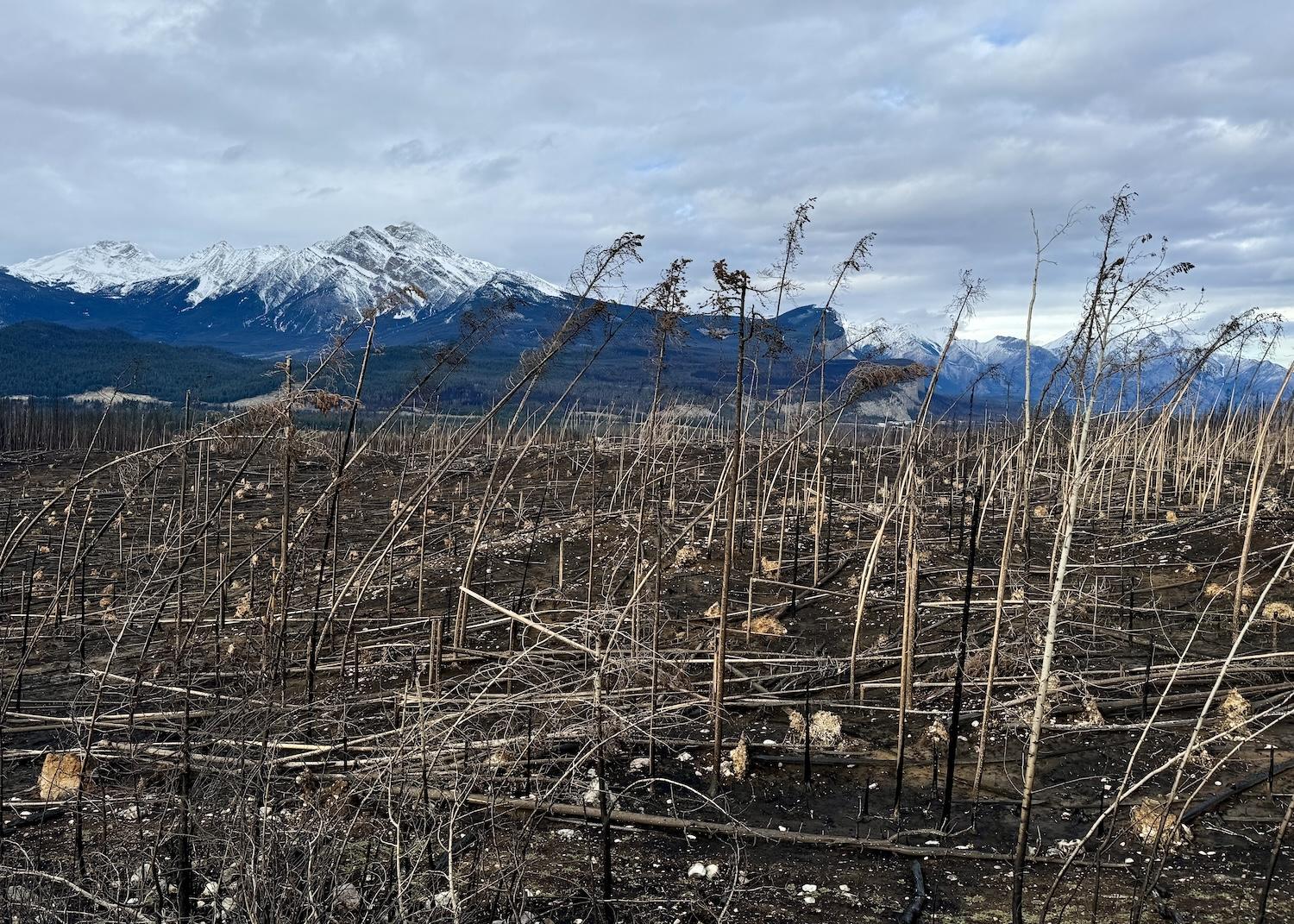
On Maligne Lake Road, near Maligne Lookout, you can see forest decimated by the Jasper Wildfire Complex/Jennifer Bain
With Jasper Food Tours, I pop into four restaurants for the Downtown Foodie Tour. While eating everyting from beef ribs, poutine and salmon crudo to Mexican tacos and maple pecan cheesecake, I learn why each spot is special to the community.
I am the only person on that particular tour, but am grateful that it went ahead. “Don’t be scared to come,” guide Natasha Goy told me. “Please enjoy. Just be mindful. You don’t know what anybody is going through.” The company’s new Wildfire Peak-Nic tour resumes next summer taking people hiking through severely impacted sites and seeing new growth forest before having lunch.
Parks Canada, meanwhile, has been busy doing recovery work inside and outside of the town. It has removed hazardous trees, replaced damaged infrastructure, done landscape restoration and restored power to Marmot Basin while grappling with the loss of, among other things, 400 picnic tables.
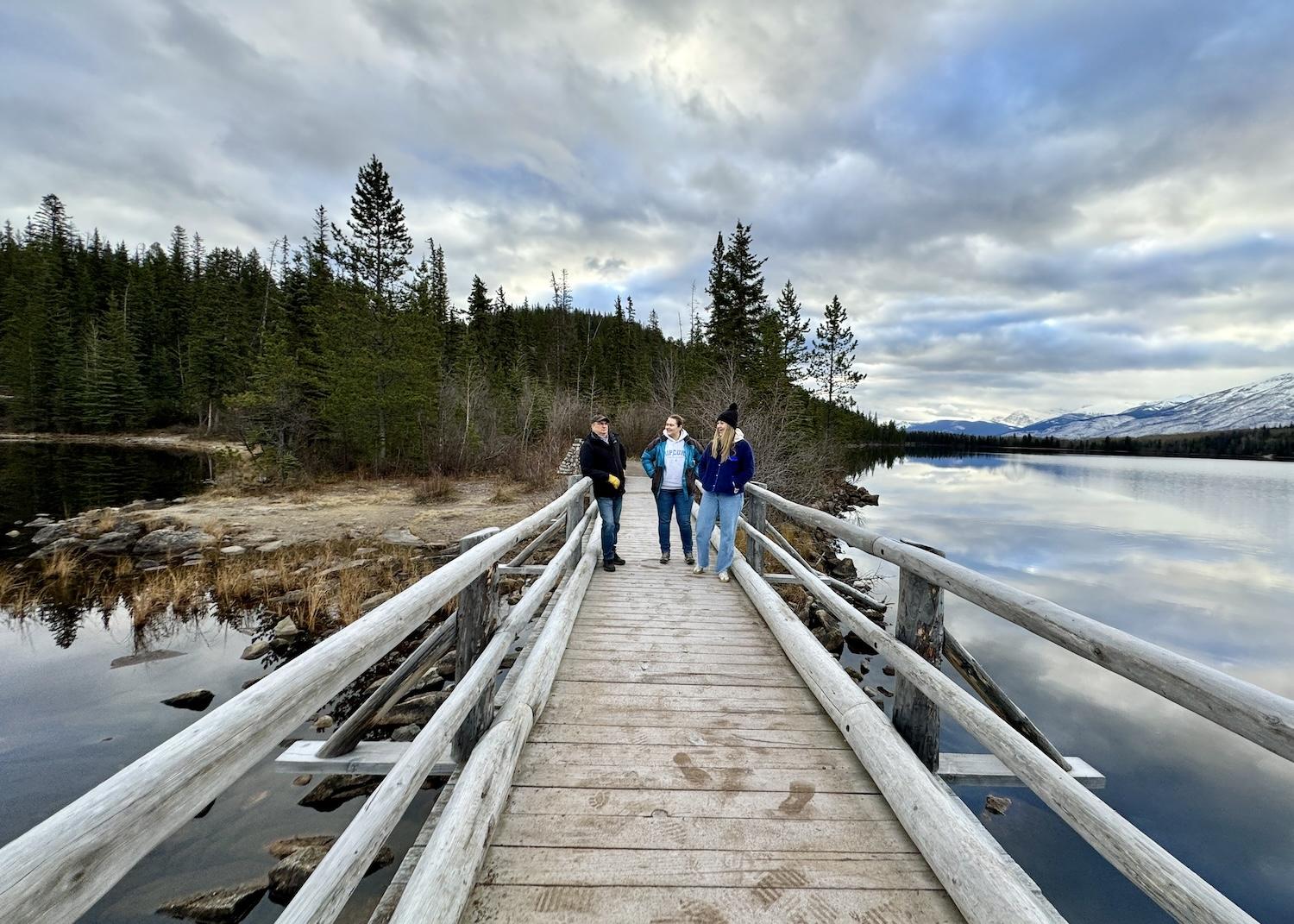
SunDog Tours guide Kevin Lazzari takes Australian tourists Jill and Keryn McAullay over the footbridge to Pyramid Island on the Winter Wildlife of Jasper and the Ecology of Fire tour/Jennifer Bain
While most of Jasper’s treasured outdoor spots are ready for winter visitors, fire-damaged areas do bring new hazards. People who stray off open and designated trails could be hit by falling trees and branches. With less vegetation to absorb water, there’s a higher risk of flash floods, dangerous stream crossings, landslides and rock falls.
“Want to be part of the healing?” the park asks. “It may seem inviting to explore into the depths of the burned forest but it is important to stay on official trails to protect the delicate state of our ecosystem in these areas.”
One morning, I drive down the Icefields Parkway, heading south towards Banff, to see fire-licked highway signs and charred forests. The next day, I join SunDog Tours for a new offering called Winter Wildlife of Jasper and the Ecology of Fire.
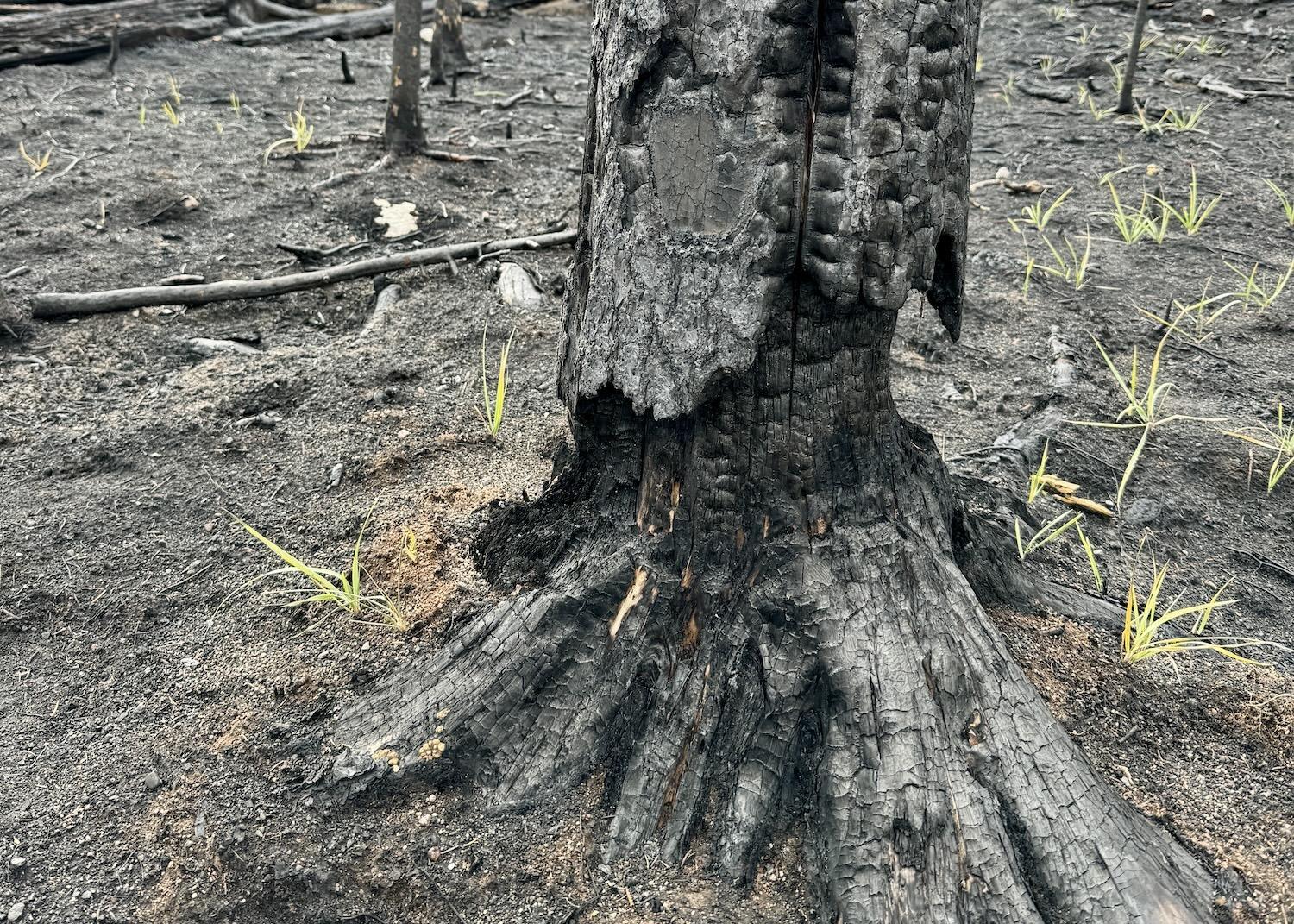
On a trail around Lake Annette, greenery sprouts up beside a charred tree trunk/Jennifer Bain
There are just three of us on that tour. Two Australians — sisters Jill and Keryn McAullay — weren’t sure what to expect when they told people in Banff they were coming to Jasper. “Oh, the whole thing burned down,” one server warned them.
But with Kevin Lazzari as our guide, we drive around the park for more than three hours.
We see how fire touched Lake Annette but not Pyramid Lake. We respectfully avoid residential areas but take in multiple views of the “Old Man Mountain” that locals dearly love and reference whenever they can, joking about how he has a white beard in winter and how he shaved his beard when the snow melts. We end at Maligne Lookout overlooking a devastated forest after hearing Lazzari's harrowing tale of the night everyone had to evacuate on short notice.
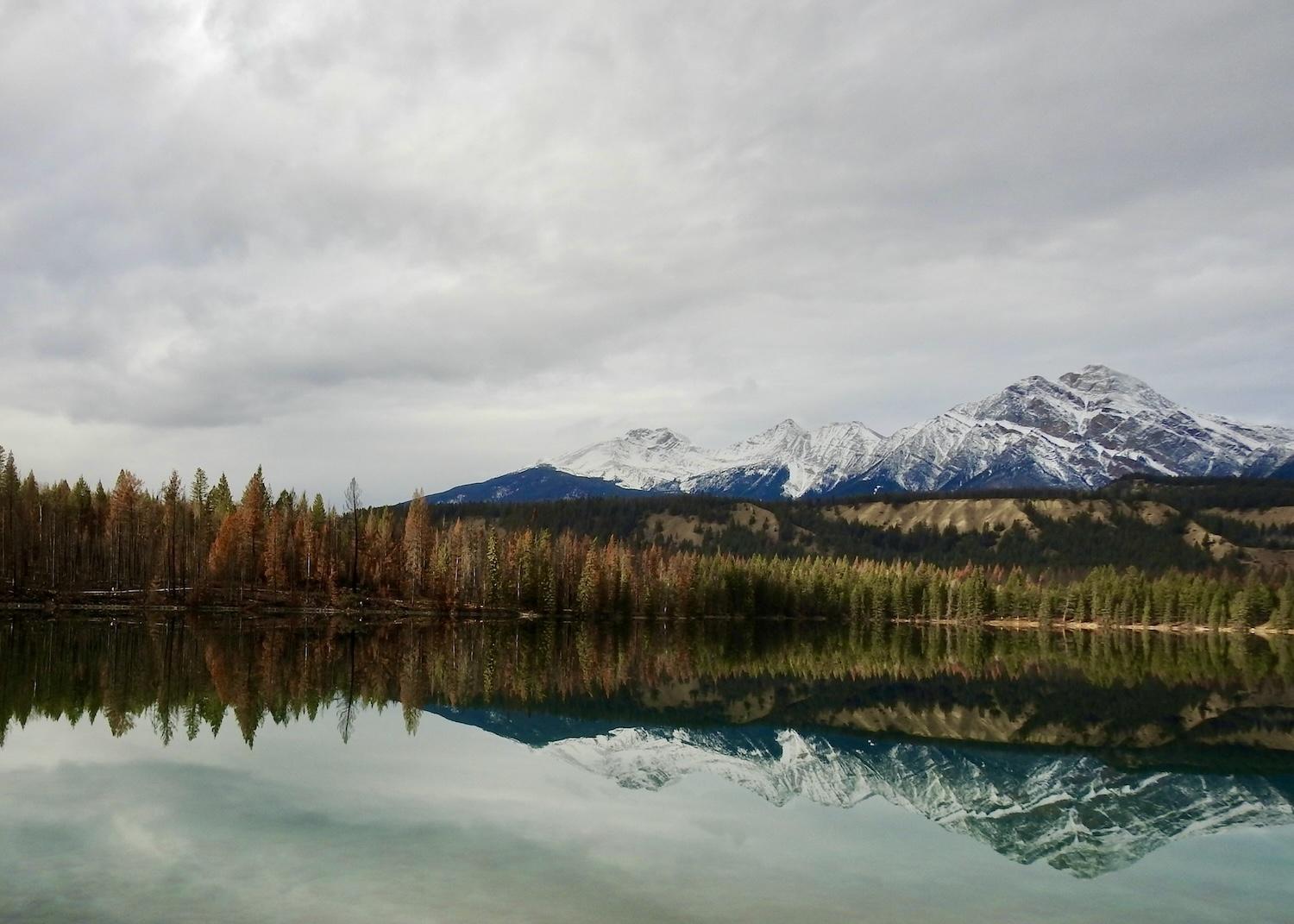
Lake Annette is a spring-fed lake with a beach in Jasper National Park. There's a 2.4 kilometre (1.5 mile) trail around it/Jennifer Bain
Lake Annette is home to a popular local beach and is surrounded by a short trail. Through the once-dense forest, I see my first giraffe/cheetah/leopard trees and plenty of budding greenery.
Pausing by the charred stump of one tree, Lazzari said “this just shows you the heat. That tree just exploded.” Pausing by new greenery, the born-and-raised Jasperite confided that “all the locals can’t wait until next spring to see all that new growth and see all the animals they haven’t seen before.” While the fire had a terrible human cost, wildfires are a natural part of forest ecosystems and contribute to improved forest health.
Jasperites are now preparing to rebuild with climate and fire resilience in mind. That means new wood siding and wood shingles are banned and landscaping plans must align with FireSmart Canada recommendations. One goal is to increase housing options in a tourist town where the vacancy rate has been 0.4 per cent for nearly two decades.
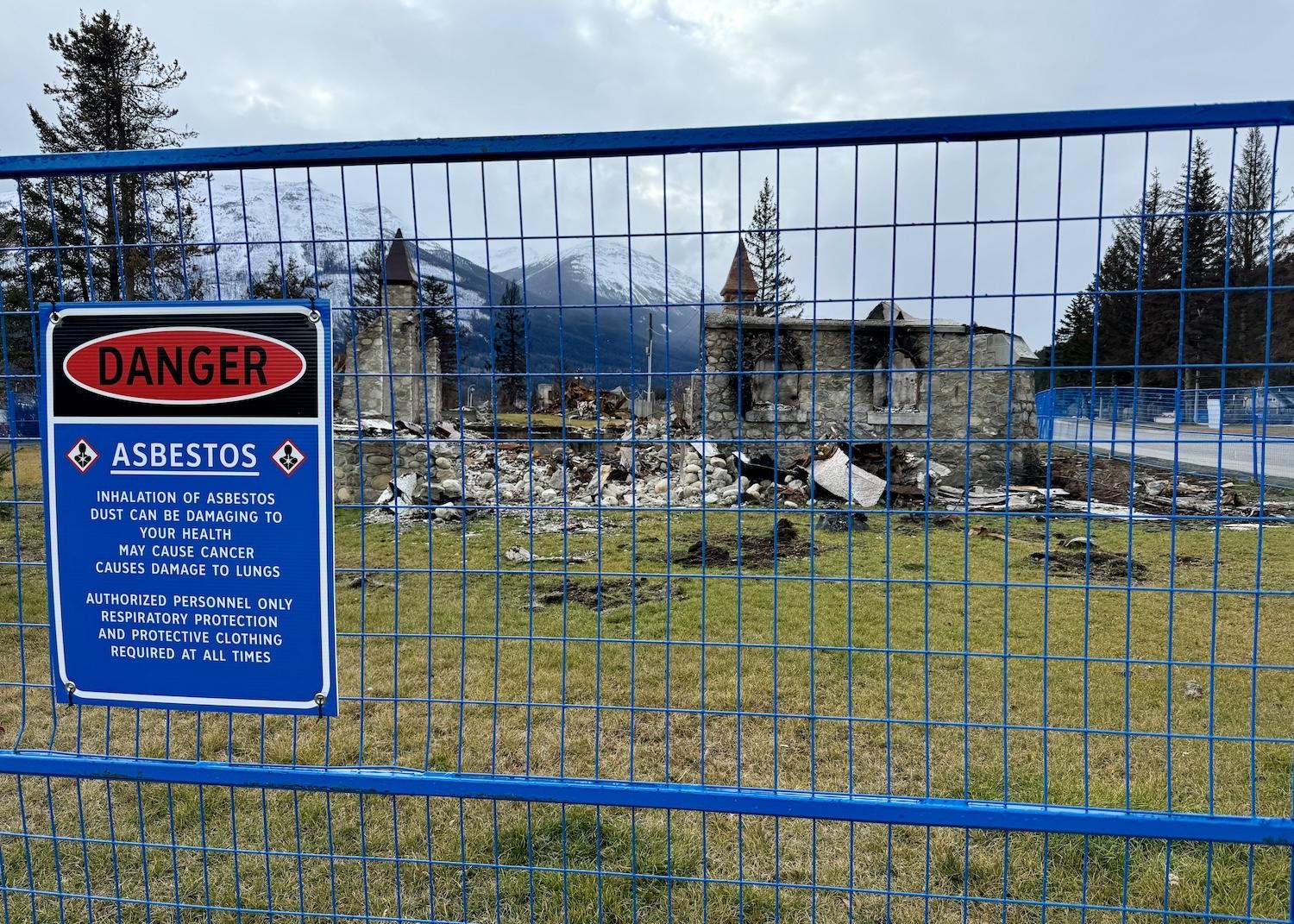
By the ruins of a church, a warning about asbestos dust serves as a stark reminder of the havoc wreaked by a wildfire/Jennifer Bain
When I wander parts of downtown core, the only trace of the devastating fire is some charred whisky bottles salvaged from a basement and displayed in the new Maligne Range restaurant. But by the ruins of a church, there's a safety fence plastered with signs warning about the perils of inhaling asbestos dust. At the west end of town, near a heavily impacted residential area, I obey signs in the middle of the road saying “Recovery area — local access only.”
Tourism may be vital here, but only those practicing responsible tourism are welcome.
Before leaving, I give the town’s beloved mascot — Jasper the Bear — a hug. The iconic statue, based on a cartoon about a goofy looking black bear, survived the fire. The bear was created decades ago to stress the importance of environmental stewardship, and it's surely a good omen that he survived the Jasper Wildfire Complex of 2024.

The beloved Jasper the Bear statue survived the 2024 wildfire/Jennifer Bain



 Support Essential Coverage of Essential Places
Support Essential Coverage of Essential Places






